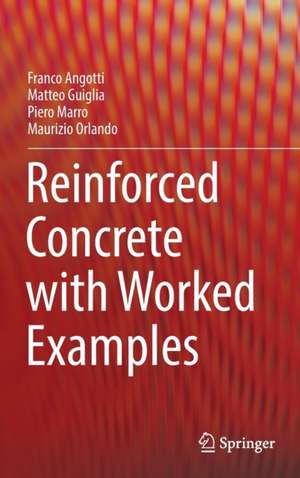Reinforced Concrete with Worked Examples
Autor Franco Angotti, Matteo Guiglia, Piero Marro, Maurizio Orlandoen Limba Engleză Hardback – 8 iun 2022
| Toate formatele și edițiile | Preț | Express |
|---|---|---|
| Paperback (1) | 615.97 lei 6-8 săpt. | |
| Springer International Publishing – 9 iun 2023 | 615.97 lei 6-8 săpt. | |
| Hardback (1) | 817.43 lei 6-8 săpt. | |
| Springer International Publishing – 8 iun 2022 | 817.43 lei 6-8 săpt. |
Preț: 817.43 lei
Preț vechi: 996.86 lei
-18% Nou
Puncte Express: 1226
Preț estimativ în valută:
156.44€ • 162.72$ • 129.15£
156.44€ • 162.72$ • 129.15£
Carte tipărită la comandă
Livrare economică 12-26 aprilie
Preluare comenzi: 021 569.72.76
Specificații
ISBN-13: 9783030928384
ISBN-10: 3030928381
Ilustrații: XIX, 847 p. 477 illus., 50 illus. in color.
Dimensiuni: 155 x 235 mm
Greutate: 1.46 kg
Ediția:1st ed. 2022
Editura: Springer International Publishing
Colecția Springer
Locul publicării:Cham, Switzerland
ISBN-10: 3030928381
Ilustrații: XIX, 847 p. 477 illus., 50 illus. in color.
Dimensiuni: 155 x 235 mm
Greutate: 1.46 kg
Ediția:1st ed. 2022
Editura: Springer International Publishing
Colecția Springer
Locul publicării:Cham, Switzerland
Cuprins
General structural design criteria.- Materials.- Durability and cover to reinforcement.- Structural analysis.- Analysis of second order effects with axial load.- Prestressed concrete.- Ultimate limit state for bending with or without axial force.- Shear and torsion at ultimate limit state.- Punching shear.- Strut and tie models.- Serviceability limit states (SLS).- Detailing of reinforcement and structural members for buildings.- Tables and Diagrams.
Notă biografică
Franco Angotti is professor emeritus of Strength of Materials at the University of Florence, Italy. He is President of the Italian Mirror Committee to the European Committee CEN/TC250/SC2 “Concrete Structures”, member of the Committee for Technical Standards of the Italian National Research Council (CNR) and the Task Group of the Italian High Council of Public Works for the definition of National Determined Parameters of Eurocodes. He is Presidentof the Italian Association for Reinforced and Prestressed Concrete (AICAP).
Matteo Guiglia has a PhD in Structural Engineering from the Turin Polytechnic, Italy. He delivers both consultancy and structural design services at both national and international level. He is member of the Task Group T2.1 “Serviceability models” of the Fédération Internationale du Béton (fib).
Piero Marro is professor emeritus of Strength of Materials at the Turin Polytechnic, Italy. As an affiliated to the Comité Euro-International du Béton (CEB) since 1975, he participated in the drafting of Model Code 1978 and Model Code 1990 and in the conversion of EC2 from provisional to definitive standard in 2004. He is a "fib Life Member" and corresponding member of the Turin Academy of Sciences.
Maurizio Orlando is associate professor of Structural Analysis and Design at the School of Engineering of the University of Florence, Italy. His research focuses on theoretical and experimental analysis of reinforced concrete structures under both static and seismic loading. He is member of the Working Group CEN/TC 250/SC 2/WG 104 "Shear, punching, torsion" dealing with the revision of section 6 of Eurocode 2, Vice President of the Italian Mirror Committee to the European Committee CEN/TC250/SC2 “Concrete structures” and Secretary of the Italian Association for Reinforced and Prestressed Concrete (AICAP).
Matteo Guiglia has a PhD in Structural Engineering from the Turin Polytechnic, Italy. He delivers both consultancy and structural design services at both national and international level. He is member of the Task Group T2.1 “Serviceability models” of the Fédération Internationale du Béton (fib).
Piero Marro is professor emeritus of Strength of Materials at the Turin Polytechnic, Italy. As an affiliated to the Comité Euro-International du Béton (CEB) since 1975, he participated in the drafting of Model Code 1978 and Model Code 1990 and in the conversion of EC2 from provisional to definitive standard in 2004. He is a "fib Life Member" and corresponding member of the Turin Academy of Sciences.
Maurizio Orlando is associate professor of Structural Analysis and Design at the School of Engineering of the University of Florence, Italy. His research focuses on theoretical and experimental analysis of reinforced concrete structures under both static and seismic loading. He is member of the Working Group CEN/TC 250/SC 2/WG 104 "Shear, punching, torsion" dealing with the revision of section 6 of Eurocode 2, Vice President of the Italian Mirror Committee to the European Committee CEN/TC250/SC2 “Concrete structures” and Secretary of the Italian Association for Reinforced and Prestressed Concrete (AICAP).
Textul de pe ultima copertă
This textbook describes the design of reinforced and prestressed concrete structures according to the latest advances both in the field of materials, concrete and steel, and in the field of structural analysis. These advances have been included in current version of Eurocode 2, which is taken as reference. All subjects are presented starting from their theoretical bases and passing to corresponding EC2 formulations. A large part of the book is concerned with the most innovative EC2 parts, like nonlinear structural analyses, second-order effects, punching and strut-and-tie models. The textbook is equipped with numerous worked examples, useful for the reader who is not familiar with the design of reinforced and prestressed concrete structures by the Limit State Method. Examples have been chosen among the most frequent cases of the professional practice. Thanks to this structure, it can be of interest both to structural designers for their professional training and to students of engineering and architecture schools for their studies. The volume contains twelve chapters, which follow the same structure of EC2, except for chapter 6 (dealing with prestressed concrete structures), which does not match any chapter of EC2, as prestressed concrete is considered in EC2 as a particular case of reinforced concrete, and corresponding formulations are shed over different chapters.
Caracteristici
Features the current edition of Eurocode 2: Design of concrete structures (abbreviated EN 1992 or EC 2) Maximizes understanding of real-world design challenges with clear examples and guided problems Stands as a learning resource for students of structural design and analysis courses
